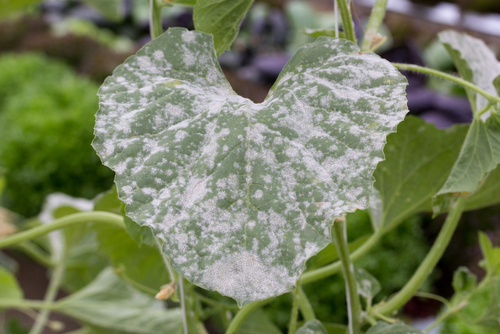How to treat powdery mildew on pumpkins is a top searched query. If you have your kitchen garden, you might be familiar with the fungal diseases plants can have. Powdery mildew is one such infection which affects pumpkin plants.
It is a very common disease among pumpkin plants that can be cured successfully if treated quickly. This disease does not typically kill the plant but facilitates the conditions under which premature falling and drying of leaves, buds, and fruits occur. It leaves your pumpkin plant unpleasant and will spread if left untreated.
Preventing powdery mildew in the first place is always better than treating it, and this article provides practical tips on how to avoid this fungal disease from infecting your pumpkin plants.
So, are you worried because you can see similar patches on your pumpkin plant? Don’t worry; we have got your back. Read this article till the end to know how to treat powdery mildew on pumpkins.
How To Treat Powdery Mildew On Pumpkins

Powdery Mildew looks unpleasant and even can worry you about your pumpkin plant. But we have got good news for you. This fungal disease can easily be treated if you diagnose it before it gets fatal.
Don’t worry; all you need is strict observation power to predict white powdery mildew on your pumpkin plants. The disease can only go to its fatal stage when left untreated.
You can initially see white powdery spots on the stems and leaves of your pumpkin plant. These are the fungus that eventually grows and affects the yield of your plant.
Now, before you learn how to treat powdery mildew on pumpkins, you must learn about the life cycle of Mildew Fungi. This white powdery mildew fungus is already there in our environment. First, it produces spores carried by various carriers like wind, animals, water, etc.
When they spot a proper host, they land on them and infect them. This infection sprays over the plant with time, and eventually, the plant dies.
So, during the spring, you must take extra care of your plants and look for any white powdery patches on them. You can cure it right there if you see minimal damage due to infection. For example, if you see one to two infected leaves, blossoms, or vine, remove them in the first place.
However, the infection can reoccur if your plant is still providing favorable conditions for the same. So, take a little extra care during the spring to avoid fungal infections. Once you have spotted some infection, remove it and expose your pumpkin plant to proper sunlight and air to kill the remaining traces of the fungus.
Fertilizers can be used to keep control of the fungus. Make sure to use a slow-release fertilizer. More specifically, you will need a fungicide to control the white powdery mildew.
Some oils are also used for ages to treat powdery mildew on pumpkins. Among them, neem and jojoba oil work the best. Other horticultural oils can also be used with proper knowledge.
Next to oils, sulfur spays are also very effective. But since you are using sulfur, you must take many precautions. First, make sure not to apply the spray up to 2 weeks after applying the oils.
You should also keep a temperature check before spraying sulfur. Do not use the sulfur spray if the temperature exceeds 32 degrees Celcius.
If the above remedies of treating powdery mildew on pumpkins sound too difficult to you, your last option is to go for a biological fungicide like Serenade. It contains natural microorganisms that kill fungal pathogens.
It is easy to use as it won’t have any side effects on humans, pets, and plants. However, this is not as effective as oils and sulfur.
What Causes White Powdery Mildew?

As discussed in the previous section, White Powdery Mildew is caused by a very common leaf infecting disease. Powdery mildew is actually a group of a fungus with different hosts. But in this article, we will only be talking about the one with the pumpkin plant as the host.
You can recognize it by its grayish-white powdery appearance, specifically the leaves and stems of a pumpkin plant that thrives in warm weather and won’t even require moisture to grow.
Also see: How Much Does The Average Pumpkin Weigh
Conclusion
Now that you know how to treat powdery mildew on pumpkins, you don’t have to worry about your plant’s infection. Instead, with a little surveillance and care, you can yield perfect pumpkins for your coming thanksgiving.
So, concentrate on the symptoms of the disease and treat them immediately before it goes fatal. For more information, you can go to a nursery or plant specialist.
Frequently Asked Questions
Can Powdery Mildew Survive In Soil?
Powdery mildew is a fungal disease that occurs on the leaves and stems of pumpkin plants. However, it can also survive easily in soil, compost, mulch, or plant debris.
How Long Does It Take To Get Rid Of Powdery Mildew?
Different techniques will do it in the different time span. For example, fungicides can work faster than oils. However, oils are more effective. So, it would help if you choose wisely on how much time you have and the condition of the infection. But, in general, the effects of your treatment will be visible within three to four weeks.
Does Overwatering Cause Powdery Mildew?
Overwatering cannot cause Powdery Mildew, but it definitely makes your plat a better host for the fungal spores to land on. So, factors like high humidity and overwatering might promote the growth of the fungus.

Hey, I’m Lisa and I’ve been an avid gardener for over 30 years. I love writing, talking and living in the garden! Feel free to connect with me on my socials below

